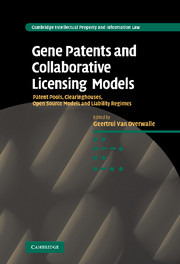 Gene Patents and Collaborative Licensing Models
Gene Patents and Collaborative Licensing Models Book contents
- Frontmatter
- Contents
- List of contributors
- Preface
- Foreword: Jean-Jacques Cassiman
- List of abbreviations
- Part I Patent pools
- Part II Clearinghouses
- 5 Clearinghouse mechanisms in genetic diagnostics. Conceptual framework
- 6 Case 3. The Global Biodiversity Information Facility (GBIF). An example of an information clearinghouse
- 7 Case 4. BirchBob. An example of a technology exchange clearing house
- 8 Case 5. The Public Intellectual Property Resource for Agriculture (PIPRA). A standard license public sector clearinghouse for agricultural IP
- 9 Case 6. The Science Commons Material Transfer Agreement Project. A standard licence clearinghouse?
- 10 Case 7. The collective management of copyright and neighbouring rights. An example of a royalty collection clearinghouse
- 11 Comment on the conceptual framework for a clearinghouse mechanism
- Part III Open source models
- Part IV Liability regimes
- Part V Different perspectives
- Part VI Summary and concluding analysis
- Index
- Titles in the series
6 - Case 3. The Global Biodiversity Information Facility (GBIF). An example of an information clearinghouse
from Part II - Clearinghouses
Published online by Cambridge University Press: 14 January 2010
- Frontmatter
- Contents
- List of contributors
- Preface
- Foreword: Jean-Jacques Cassiman
- List of abbreviations
- Part I Patent pools
- Part II Clearinghouses
- 5 Clearinghouse mechanisms in genetic diagnostics. Conceptual framework
- 6 Case 3. The Global Biodiversity Information Facility (GBIF). An example of an information clearinghouse
- 7 Case 4. BirchBob. An example of a technology exchange clearing house
- 8 Case 5. The Public Intellectual Property Resource for Agriculture (PIPRA). A standard license public sector clearinghouse for agricultural IP
- 9 Case 6. The Science Commons Material Transfer Agreement Project. A standard licence clearinghouse?
- 10 Case 7. The collective management of copyright and neighbouring rights. An example of a royalty collection clearinghouse
- 11 Comment on the conceptual framework for a clearinghouse mechanism
- Part III Open source models
- Part IV Liability regimes
- Part V Different perspectives
- Part VI Summary and concluding analysis
- Index
- Titles in the series
Summary
Introduction
The Global Biodiversity Information Facility (GBIF) is an example of an information clearinghouse that focuses on biological diversity, primarily at the species and specimen levels. Although GBIF does contain some genetic information (especially about cultivars or varieties archived in living stock centres), it does not provide access to any patent data and all the information it provides is freely and openly available to all users. Therefore, GBIF does not provide a very apt model for gene patents. However, GBIF does provide some interesting lessons for how to assemble a distributed network of information.
Background
GBIF is an international organisation designed to make the world's biodiversity data freely and universally available via the Internet, for the benefit of science, society and a sustainable future. It was established in 2001 as a result of deliberations and discussions in the OECD's Global Science Forum.
However, GBIF is a free-standing organisation, not directly linked to the OECD or United Nations. It is based upon a unique Memorandum of Understanding, but has no formal standing in international law.
Inspirational models for the formation of GBIF included the International nucleotide sequence databases (GenBank, EMBL and DDBJ); Mexico's CONABIO (Comisión nacional para el conocimiento y uso de la biodiversidad); Costa Rica's INBio (Instituto Nacional de Biodiversidad); and Australia's ERIN (Environmental Resources Information Network). GBIF was able to build upon these pioneering national activities to develop its international approach.
- Type
- Chapter
- Information
- Gene Patents and Collaborative Licensing ModelsPatent Pools, Clearinghouses, Open Source Models and Liability Regimes, pp. 120 - 124Publisher: Cambridge University PressPrint publication year: 2009


